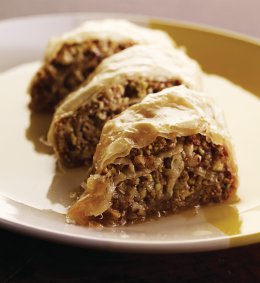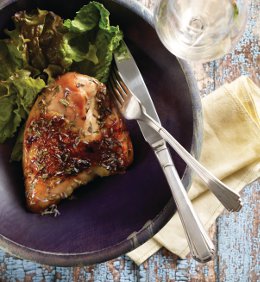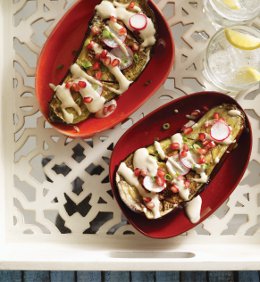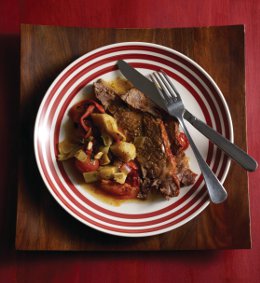 Iran’s Attack on Israel
Iran’s Attack on Israel


3 min read
7 min read
4 min read
7 min read
International cuisine from a new cookbook in the bestselling series.
 yields 10-12 servings
yields 10-12 servings
My all-time favorite stop in Machane Yehuda and in the new Sarona Market in Tel Aviv is Halva Kingdom. I think I have sampled all 60 flavors, or maybe that’s just the dream. This business was founded in 1947 by the grandfather of the current shop owner, Eli Maman. After the expulsion of Jews from the Old City of Jerusalem, the family moved the shop to Machane Yehuda Market. The recipe of their famous halvah is from Morocco, and it is hand-made with traditional methods from organic sesame seeds imported from Ethiopia.
This recipe, with its addition of halvah to baklava, is another gem that I learned at Te’amim Cooking School in Jerusalem (see page 16). The richness that the halvah adds to the baklava is outrageous.
Pastry
Filliing
Honey Syrup
Preheat the oven to 375°F. Line a jellyroll pan with parchment paper. Set aside.
Prepare the filling: Place the pistachios, almonds, pecans, halvah, and vanilla into the bowl of a food processor fitted with the metal “S” blade. Pulse until ground but not a paste. Set aside.
Prepare the syrup: Place the sugar, honey, water, and lemon juice into a medium pot. Over medium heat, bring to just a boil. Turn down to a simmer; cook for 10 minutes. Set aside.
Place a sheet of phyllo lengthwise on the work surface. Brush with canola oil. Top with another layer of phyllo. Brush with canola. Top with a third layer of phyllo and oil. Roll all four edges ½-inch inward to make a frame. Brush rolled edges with oil.
Spread a thick layer of the nut filling over the phyllo. Starting with a short end, roll up, jellyroll fashion; transfer to prepared sheet. Repeat, making 4 more rolled logs. Brush the logs with oil. Using a serrated knife, cut 4 diagonal slits across the top of each log.
Bake, uncovered, for 12 minutes, or until golden. Remove from oven and immediately spoon the syrup over the logs. Slice each log into 4-5 slices. Serve 2 slices to a plate. Drizzle with more syrup around the plate.
 yields 4-6 servings
yields 4-6 servings
Summertime is the season to seek out the spectacle of stunning purple lavender surrounding the Luberon villages in Provence, France. The color, texture, and scent of lavender are at the heart of this area’s fame. While there, I visited the Lavender Museum to learn about the healing properties of lavender, experience the lotions, teas, medicinal properties, and – most important to me – the beauty of cooking with culinary lavender. The gorgeous flecks of purple in this dish and its role in the herby French spice blend Herbs du Provence cause this dish to shine. Serve this chicken over an herbed rice pilaf.
Preheat the oven to 400°F.
Place the chicken into an oven-to-table casserole dish. Massage the canola oil into the chicken; sprinkle with salt.
In a small bowl, combine the honey, Herbs du Provence, rosemary, cayenne, and vinegar. Set aside.
Bake the chicken for 35 minutes, uncovered. Then, baste the chicken every 10 minutes with the honey-lavender mixture until cooked through and nicely browned. Total cooking time should be about 1 hour.
Garnish with fresh rosemary sprigs or other fresh herbs.
 yields 6 servings
yields 6 servings
Eggplant in some form or another can be found on every restaurant menu in Israel. Halved roasted eggplant is the ambassador of these appetizers. Gorgeous, simple, and healthy, with its smoky aroma and smooth cooked center, it is the perfect starter. Roasting the eggplants on the open flame adds so much flavor but can be a bit messy; make sure to cover the grates with foil to catch the charred skin – or follow this recipe for an oven-baked version.
Silan Techina
Roasted Eggplant
Prepare the silan techina: In the bowl of a food processor fitted with the metal “S” blade, purée the tahini, lemon juice, garlic, salt, pepper, ½ cup warm water, and silan. You may need a bit more warm water to thin to desired consistency. Set aside.
Prepare the roasted eggplant: Preheat the oven to 400°F. Cut the eggplants in half lengthwise, cutting straight through the green stalk. Using a small sharp knife, make 3-4 “X” marks to score the eggplant flesh without cutting through to the skin.
Place the eggplant halves, cut-side up, on a baking sheet lined with parchment paper. Brush them heavily with olive oil. Sprinkle with salt and pepper. Roast for 35-40 minutes; the flesh should be soft, flavorful, and nicely browned. Remove from the oven; allow to cool.
Transfer the roasted eggplant to a platter or plates for serving. Drizzle on the silan techina; garnish with pomegranate seeds, radish slices, and scallions.
 yields 6-8 servings
yields 6-8 servings
In the weeks before teaching in Tuscany for the first time, I dreamed about the food, the ingredients, and the flavors that I would encounter. I surrounded myself with all things Italian. I wandered the streets of Arthur Avenue in the Bronx, the aisles of Eataly in New York, the shelves of travel books in Barnes and Noble. Then Shabbos came and I needed to cook a roast. Inspired by Italian fare, I developed this recipe, which has become a family favorite. The lightness of the ingredients allows the meat to shine without being masked by heavy wine flavors that sometimes dominate roasts.
Heat the oil in a large pot over medium heat. Add the meat; sear for 4-6 minutes per side, until nicely browned. Using tongs, remove the meat to a plate or cutting board.
To the pot, add drained artichokes, red peppers, fresh basil, garlic, onion, tomatoes, dried basil, oregano, and pepper. Sauté for 5 minutes; stirring occasionally, until fragrant, scraping up the browned bits from the bottom of the pot. Return the meat to the pot. Add water to come halfway up on the roast. Click here to order your copy of Kosher by Design: Brings It Home
In a small bowl, stir together tomato paste and wine. Pour over the meat. Cover the pot. Turn the heat to low; simmer, covered, for 3 hours.
 Allow meat to cool. Transfer to a cutting board; slice against the grain, using a serrated knife. Using a slotted spoon, transfer the vegetables to a platter. Arrange the meat in the center. Return the heat to high; reduce the juices for 5-6 minutes to concentrate the flavor. Drizzle the roast with pan juices.
Allow meat to cool. Transfer to a cutting board; slice against the grain, using a serrated knife. Using a slotted spoon, transfer the vegetables to a platter. Arrange the meat in the center. Return the heat to high; reduce the juices for 5-6 minutes to concentrate the flavor. Drizzle the roast with pan juices.
Click here to purchase your copy.
